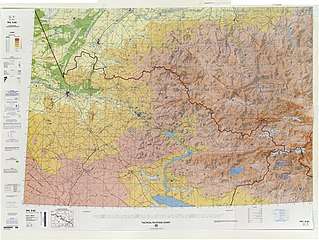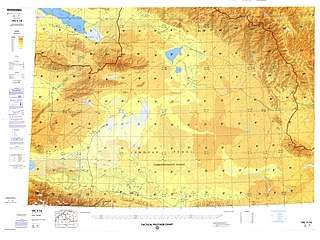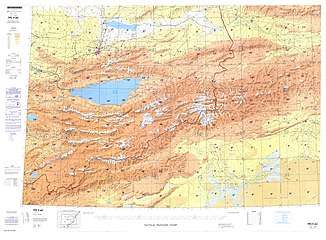China–Kazakhstan border
The China–Kazakhstan border or the Sino-Kazakhstan border (Kazakh: Қазақстан-Қытай мемлекеттiк шекарасы, Russian: Казахстанско-китайская государственная граница, Chinese: 中哈边界; pinyin: Zhōng-Hā biānjiè), is the international border between the People's Republic of China and the Republic of Kazakhstan. The border line between the two countries has been largely inherited from the border existing between the Soviet Union and the PRC and, earlier, between the Russian Empire and the Qing Empire; however, it has been fully demarcated only in the late 20th and early 21st century. According to the international boundary commissions that have carried out the border demarcation, the border is 1,782.75 km (1,107.75 mi) long.
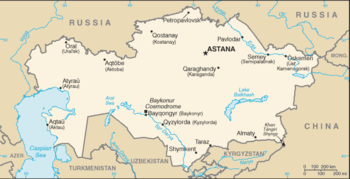
History

The origins of the border date from the mid-19th century, when the Russian Empire expanded into Central Asia and was able to establish its control over the Lake Zaysan region. The establishment of the border between the Russian Empire and the Qing Empire, not too different from today's Sino-Kazakh/Kyrgyz/Tajik border was provided for in the Convention of Peking of 1860;[1][2] the actual border line pursuant to the convention was drawn by the Treaty of Tarbagatai (1864) and the Treaty of Uliassuhai (1870), leaving Lake Zaysan on the Russian side.[3][4][2] The Qing Empire's military presence in the Irtysh basin crumbled during the Dungan revolt (1862–77). After the fall of the rebellion and the reconquest of Xinjiang by Zuo Zongtang, the border between the Russian and the Qing empires in the Ili River basin was further slightly readjusted, in Russia's favour, by the Treaty of Saint Petersburg (1881) and a series of later protocols.[2] In 1915 an agreement was signed more precisely delimiting the border the Ili Valley and Dzungarian Alatau region.[2]
The southern-most section of the frontier (i.e. roughly the southern half of the modern China–Tajikistan border) remained undemarcated, owing partly to the ongoing rivalry between Britain and Russia for dominance in Central Asia known as the Great Game; eventually the two agreed that Afghanistan would remain an independent buffer state between them, with Afghanistan’s Wakhan Corridor being created in 1895.[2] China was not a party to these agreement and hence the southern-most section of the China-Russia boundary remained undefined.[2]
After the Xinhai Revolution and the Chinese Civil War in China and the October Revolution and the Russian Civil War in Russia, the Sino-Russian border became the PRC-USSR border. However, the Chinese and Soviet authorities were not always in agreement where the border line ran on the ground, which led, in particular to a border conflict east of Lake Zhalanashkol in August 1969.
After Kazakhstan became an independent country, it negotiated a border treaty with China, which was signed in Almaty on April 26, 1994 and ratified by the President of Kazakhstan on June 15, 1995. According to the treaty, a narrow strip of hilly terrain east of Zhalanashkol which the USSR and China had contested in 1969 has become recognized as part of China.[5]
To delineate certain small sections of the border more precisely, additional agreements were signed on 24 September 1997 and 4 July 1998.[6][7] Over the next several years, the border was demarcated on the ground by joint commissions. According to the commissions' protocols and maps, the two countries' border line is 1782.75 km long, including 1215.86 km of land border and 566.89 km of border line run along (or across) rivers or lakes. The commissions' work was documented by several joint protocols, finalized with the Protocol signed in Beijing on May 10, 2002.[6][7]
In 2011 a cross-border free trade area opened on the border at Khorgos in an effort to boost Chinese-Kazakh trade.[8]
The two countries' border protection authorities carry out regular meetings and on occasions even joint border patrols.[9]
Border crossings
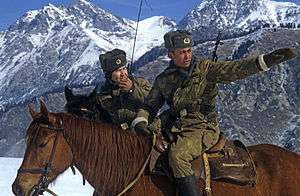

- Maikapchagai (KAZ)-Jemina (CHN) (road)[10]
- Bakhty (KAZ) - Tacheng (CHN) (road)[10]
- Dostyk/Druzhba (KAZ) – Alashankou (CHN) (road:E014,G3018 / rail:Northern Xinjiang railway)[10]
- Khorgos (KAZ) – Khorgas (CHN) (road:E012,G30 / rail:Jinghe–Yining–Khorgos railway)[10]
- Kolzhat (KAZ) – Dulart (CHN) (road)[10]
Settlements near the border
Historical maps
Historical maps of the China-Kazakh SSR border from north to south (west to east), mid & late 20th century:
International Map of the World:
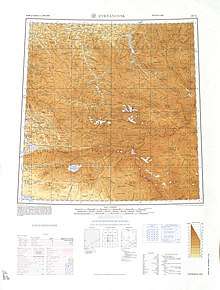 near Altai Town
near Altai Town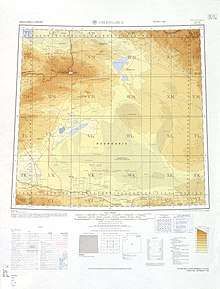 near Altay City
near Altay City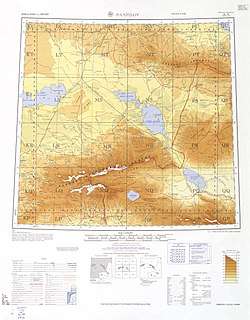 near Zharkent
near Zharkent_-_panoramio.jpg) near Aksu City
near Aksu City
Operational Navigation Chart:
 near Russian SSR (modern-day Russia)
near Russian SSR (modern-day Russia)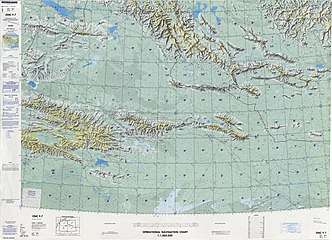
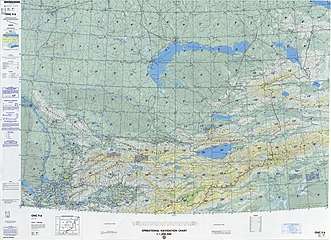 near Kirghiz SSR (modern-day Kyrgyzstan)
near Kirghiz SSR (modern-day Kyrgyzstan)
Tactical Pilotage Chart:
See also
References
- Articles 2 and 3 in the Russian text of the treaty
- International Boundary Study No. 64 – China-USSR Boundary (PDF), 13 February 1978, retrieved 23 September 2018
- (See the map)
- The Lost Frontier: the treaty maps that changed Qing's northwestern boundaries
- See the text of the "Agreement between the Republic of Kazakhstan and the People's Republic of China on the Kazakhstan-China international border, signed in Almaty on Aprel 26, 1994" in О ратификации Соглашения между Республикой Казахстан и Китайской Народной Республикой о казахстанско-китайской государственной границе. Указ Президента Республики Казахстан от 15 июня 1995 г. N 2331. The border shown on Google Maps follows the description in the treaty; specifically, border point 38 described in the text is at the border line's crossing with the Terekty River (铁列克提河,Tielieketi he) can be seen at 45°37′00″N 82°15′30″E. The 1969-era Soviet claim in the area can be seen on the period's topo maps, e.g. border point No. 40 on this map.
- О ратификации Протокола между Правительством Республики Казахстан и Правительством Китайской Народной Республики о демаркации линии казахстанско-китайской государственной границы. Закон Республики Казахстан от 4 июля 2003 года, N 469. ("On the ratification of the Protocol agreed by the Government of the Republic of Kazakhstan and the Government of the People's Republic of China on the demarcation of the line of the Kazakhstan-China international border. Law No. 469 of the Republic of Kazakhstan. July 4, 2003")
- Kazakhstan MFA - Delimitation and Demarcation of State Border, retrieved 12 September 2018
- EurasiaNEt - On China-Kazakhstan Border Lies a Lopsided Free-Trade Zone, 5 September 2014, retrieved 23 September 2018
- Chinese and Kazakh frontier defense troops patrol together along border line Archived 2013-10-17 at the Wayback Machine, Xinhua, 2011-12-09
- Caravanistan - Kazakhstan border crossings, retrieved 23 September 2018
External links
| Wikimedia Commons has media related to China-Kazakhstan border. |
- 中哈边界 (China–Kazakhstan border); shows detailed maps of border lines claimed by China and USSR/Kazakhstan, and the final treaty border
